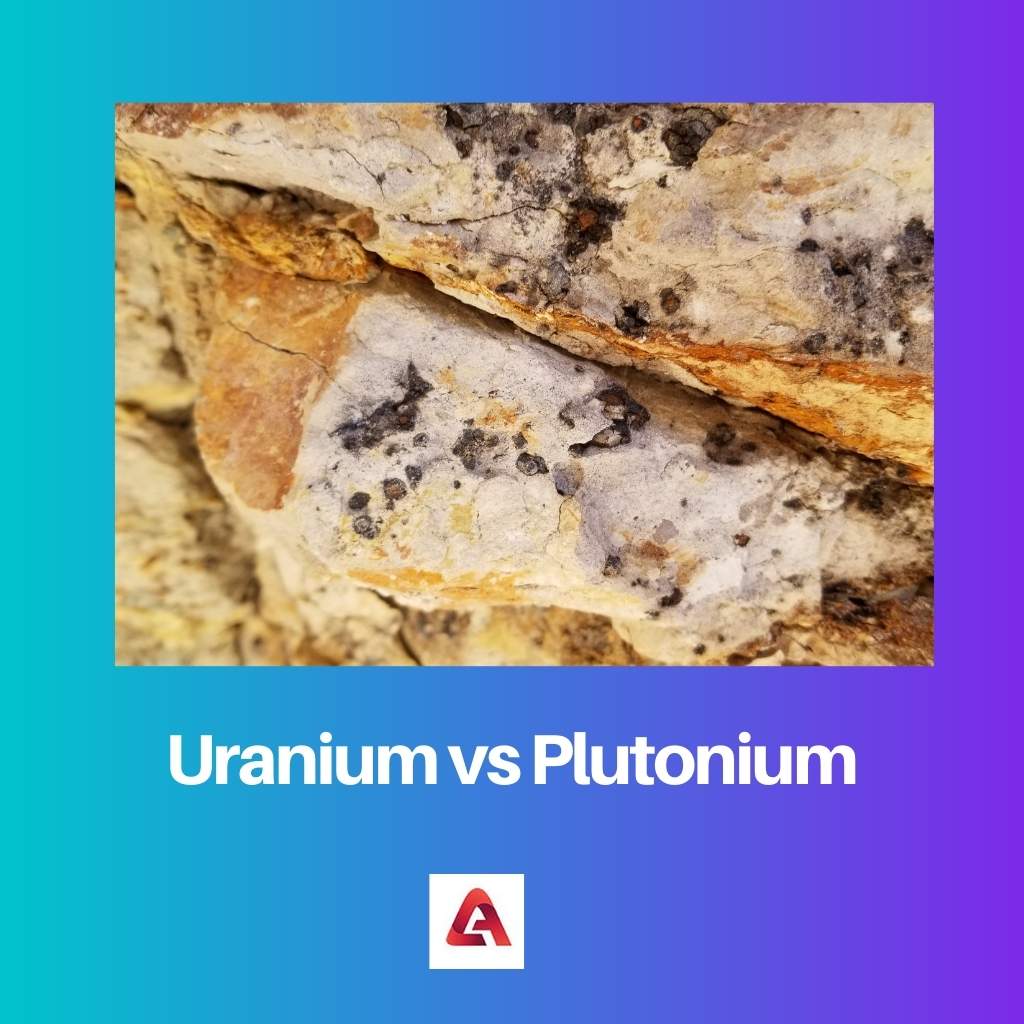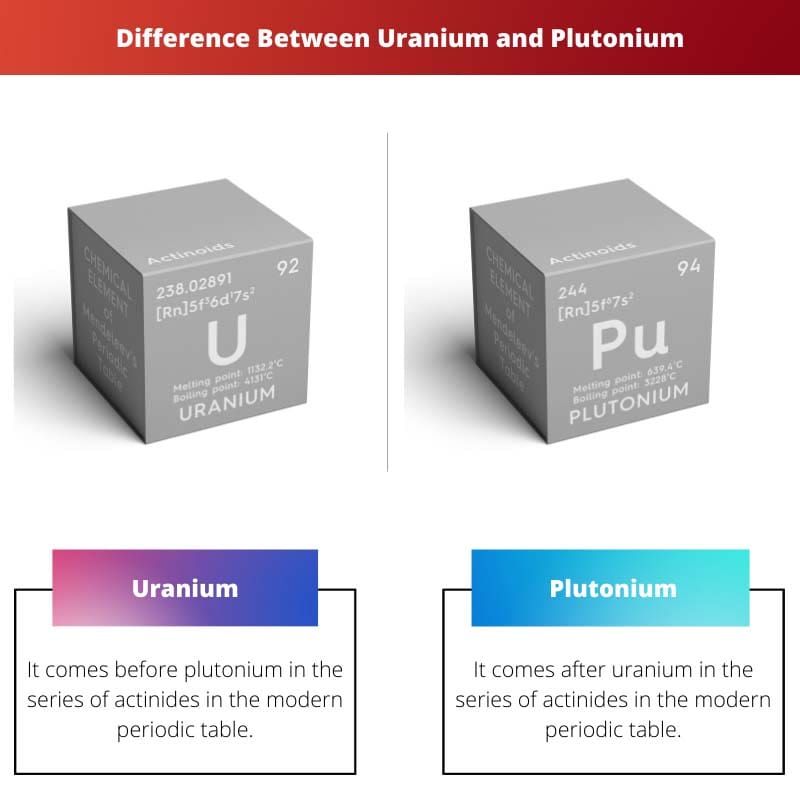Uranium and plutonium are two different types of elements that are a part of the modern periodic table. Both of these elements are used for similar purposes and are hence confused with being the same. Both these elements have different properties from one another.
They have different radioactive nature, half-life, boiling points, occurrence, atomic number, symbol, etc.
Key Takeaways
- Uranium is a naturally occurring element, while plutonium is an artificial element derived from uranium.
- Uranium-235 and uranium-238 are the most common isotopes, while plutonium-239 is the most notable isotope for plutonium.
- Both uranium and plutonium fuel nuclear reactors, but plutonium is more commonly used in nuclear weapons due to its higher fissionability.
Uranium vs Plutonium
The difference between uranium and plutonium is that uranium can be obtained in natural form from mines in the form of ores which are later purified. Plutonium, on the other hand, is such an element that it cannot be obtained naturally by any means. It is a product of the reaction between uranium-238 and neutrons.

Uranium is the 92nd child of the modern table and is further divided to be placed in the actinide block. It is considered to be radioactive in nature, meaning they radiate energy or particles as they decay.
Back in time, it was used to make green or yellow-colored glasses, vases, crockeries, and showpieces.
Plutonium is the 94th child of the modern table and is further divided to be placed in the actinide block. It is a manmade, radioactive, and naturally nonexistent element. It was derived from a reaction with uranium.
It is produced in large quantities using reactors. It could lead to an explosion if not handled properly.
Comparison Table
| Parameters of Comparison | Uranium | Plutonium |
|---|---|---|
| Placement | It comes before plutonium in the series of actinides in the modern periodic table. | It comes after uranium in the series of actinides in the modern periodic table. |
| Symbol | It is represented by a symbol of the letter U. | It is represented by a symbol of the letters Pu. |
| Boiling point | It has a higher boiling point than plutonium. | It has a lower boiling point than uranium. |
| Half-life | It has a longer half-life. | It has a shorter half-life. |
| Radioactivity | It is less radioactive than compared to plutonium. | It is more radioactive than compared to uranium. |
What is Uranium?
Uranium is a deadly element. Its name was inspired by the planet “Uranus.” Its color is silver with a pinch of white in it. One could never guess the amount of damage it can cause.
This reminds me of the fact that even owning more than one gram of uranium without a government-given license is considered a criminal offence. This is because even a small amount of this element can cause vast damage to life and property.
Uranium was found or discovered in 1789. However, even before its discovery, it was used in coloring glassware. Later after its discovery, it grabbed the attention of many scientists.
During the time of world war, many scientists started using uranium to form explosives. Many countries invested a lot of money in the making of nuclear explosives with the help of uranium.
The world recognized the power of uranium when two cities in Japan got destroyed due to a few grams of uranium. However, now many countries in the world use it for generating electricity. Australia is the country with the largest quantity of uranium, followed by Kazakhstan.
Uranium is found in the earth’s crust in the form of an ore; it is then purified through air reduction by calcium. It has several oxidation states. Pure uranium obtained from its ore is dark in color and looks like any other ordinary metal.

What is Plutonium?
Plutonium is a highly protected element. For a long time, many facts about plutonium have been undergrounded as it is considered to be a great threat. It was discovered (made) by a group of scientists back in 1914.
It was made by bombarding the salt of uranium atoms with neutrons. Hence plutonium was produced and was certified to be a useful element for the making of nuclear explosives.
Its name was inspired by the planet Pluto (no longer a planet). However, the discovery of plutonium was kept a secret for many years at that time. The US needed it to create nuclear weapons.
In 1945 an atomic bomb was created with the help of plutonium and was tested and found to be successful.
Plutonium is shiny in color. When exposed to air, its color turns greenish-yellow. Plutonium does not exist in nature, but many scientists have found a few traces of plutonium occurring in uranium ores which are mined from the earth’s crust.
However, there are no confirmed shreds of evidence about this fact. Plutonium is also made when an explosion of explosives consisting of uranium occurs.

Main Differences Between Uranium and Plutonium
- Uranium comes before plutonium in the series of actinides in the modern periodic table. They have different symbols which are used to describe their presence in different chemical reactions.
- Uranium was discovered by a scientist quite before plutonium was made. However, this is because plutonium was made out of the concept of uranium. Uranium has a higher boiling point than plutonium. The difference between titanium has a higher boiling point than plutonium. The difference between their boiling points is uranium has a higher boiling point than plutonium. The difference between their boiling points is uranium has a higher boiling point than plutonium. The difference between their boiling points is a
- Uranium has a higher boiling point than plutonium. The difference between their boiling points is about 903 degrees Celsius which can be considered to be a huge gap.
- Uranium has a very long half-life when compared to that plutonium.
- The radioactive nature of uranium is considered to be less than that of plutonium.

- https://link.springer.com/chapter/10.1007/1-4020-3598-5_5
- https://link.springer.com/chapter/10.1007/1-4020-3598-5_7

This is an interesting comparison between uranium and plutonium. I appreciate the detailed information about the differences in their properties and uses.
The historical background of uranium and plutonium is quite intriguing. It’s really interesting to know about their early uses and how they were utilized for nuclear explosives during world wars.
It’s fascinating to learn how uranium and plutonium differ in their origin and how they are utilized in nuclear reactors or nuclear weapons. The comparison table is very informative.
The historical background and the utilization of uranium and plutonium for nuclear explosives and electricity generation are quite insightful. The information about their discovery and applications is very educational.
The information about the discovery and early uses of uranium is quite intriguing. It’s interesting to know how its properties were recognized and utilized for various purposes over time.
The detailed description of the properties of uranium and plutonium in comparison is very informative. It provides a comprehensive understanding of their differences and applications.
The comparison of physical properties between uranium and plutonium helps in understanding the distinct characteristics of these elements. The explanation about their boiling points and radioactivity is very enlightening.
The information about the discovery of plutonium and its role in the development of nuclear weapons is quite intriguing. It’s interesting to see how it was utilized for significant scientific advancements.
The detailed explanation of the differences in placement, symbol, boiling point, half-life, and radioactivity between uranium and plutonium is very enlightening. It helps in understanding their unique properties.
The historical context of plutonium and its role in the development of nuclear weapons is quite fascinating. The protective measures around plutonium due to its hazardous nature are quite remarkable.